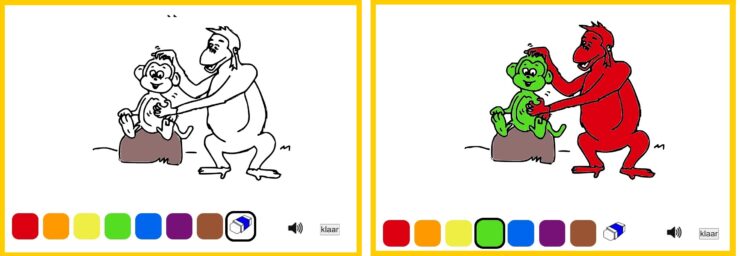A digital research method, used to assess children’s language comprehension
The Coloring Book is a digital application developed especially for linguistic research on language comprehension. Participants hear a sentence and are being asked to color a specific part of the coloring page. Their actions implicitly reveal their linguistic competence.
On a tablet or desktop, the child sees a blank coloring page. They receive an auditive description of the scene, such as “the green monkey is being scratched by the red monkey”. The child then selects the desired colors on the screen, and colors the page accordingly. If they do not understand the syntactic construction, they will color the page as if “the green monkey is scratching the red monkey”. This gives a very reliable impression of the child’s linguistic knowledge.
This method can be used to test several different aspects of children’s knowledge of language. Not only can various syntactic structures be tested, but it can also be used for assessing lexicon during primary education.
It was proven that the Coloring Book is a more natural way of doing research with children, second language speakers, and various populations with language impairments, since it has several crucial advantages over other methods:
- it is more natural: playing a digital game is a common and normal setting for children this age.
- it is automatic: participants assign the first intuitive interpretation that comes to their mind, without comparing options or considering alternatives.
- it is active: participants actually do something – and do not only answer ‘yes’ or ‘no’, or point to a picture.
- it is implicit: participants are simply coloring a picture and do not think that they are being tested. The purpose of the game is easily consealed.
- it includes only grammatically well-formed input: the instructions include only grammatical sentences and no ‘forced’ or extremely uncommon interpretations.
- it is more immune for guessing and improvising: not listening or not understanding will show immediately.
- it can be used with target groups of various age: the same test can be used with children (coloring game) and adults (presented as a memory test).
- it can be used for testing populations with language problems, such as DLD, ASS, ADHD, etcetera.
- it feels like a game and therefore reduces stress and antagonism for the participant.
In linguistic research, we want to determine the most intuitive interpretation that a subject assigns to a word or to a sentence. Actually, this is precisely what happens in real life. While reading a text or listening to speech, we automatically assign meaning to the linguistic stimulus offered to us. How to unveil that piece of information in an experimental setting? On the one hand, we want to recreate a natural situation (ecological validity). On the other, we want to have an objective measure of the phenomenon under examination.
Language comprehension is normally assessed by using the so-called pointing task (Picture Selection Task). Subjects receive an auditory or written prompt and show their interpretation by pointing to a picture out of a set of three or four that best represents their intended meaning. Many tools for assessing language proficiency (both in first and second language acquisition, as well as in clinical linguistic research) are based on the pointing-task method. This method, however, is not sufficiently precise for testing subjects’ first intuitions (implicit knowledge of grammar). In addition, having to choose out of some explicit alternatives may induce subjects to guess and provide chance answers.
The Coloring Book method stems from two crucial prerequisites:
- It must tap the first intuition that comes to mind (not the most accepted out of a set of possible answers);
- It must be both ecologically valid and scientifically measurable.
The advantages of the Coloring Book method are scientifically supported through empirical research. The main article which reviews these findings can be found here. A full list of publications supporting and making use of the Coloring Book method, can be found here .





Recent Comments